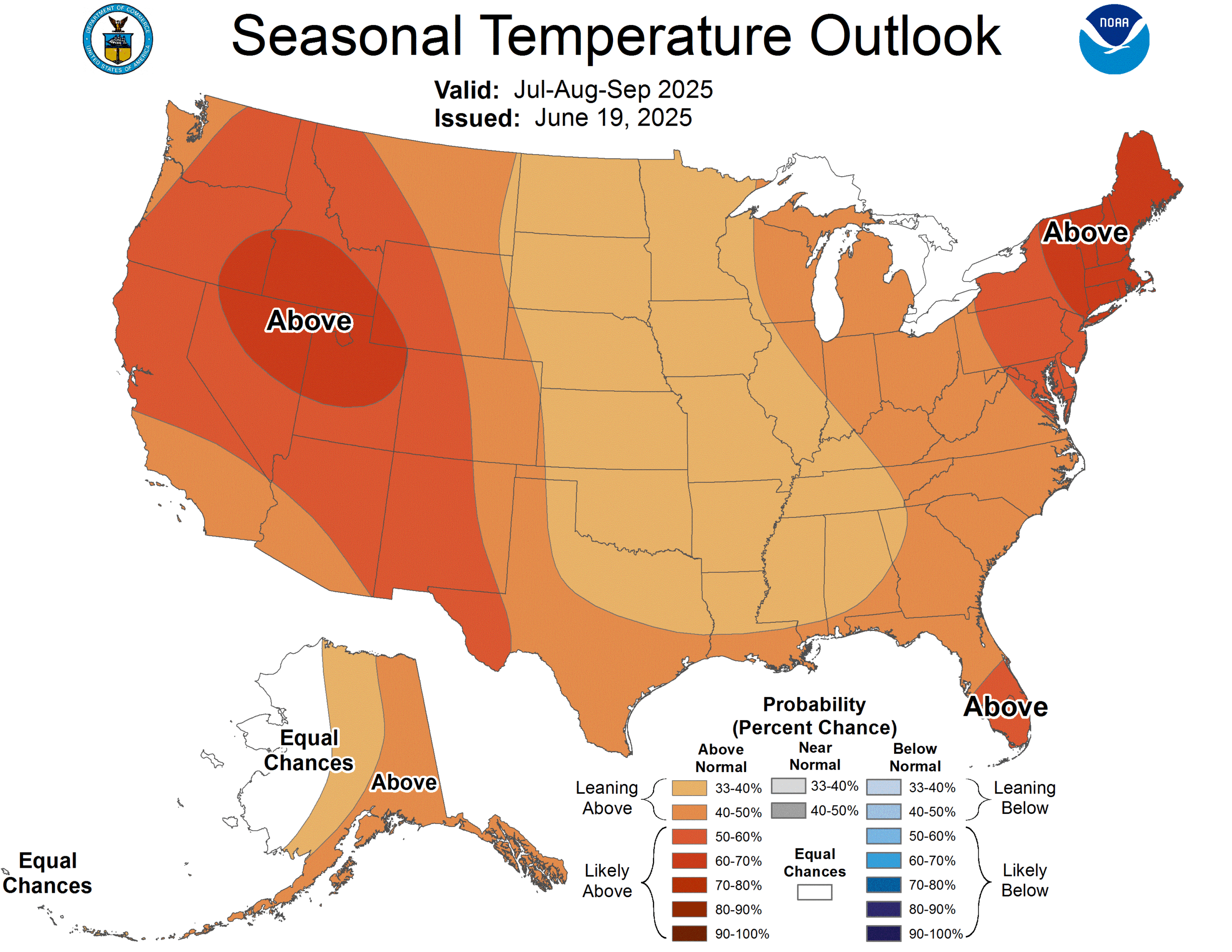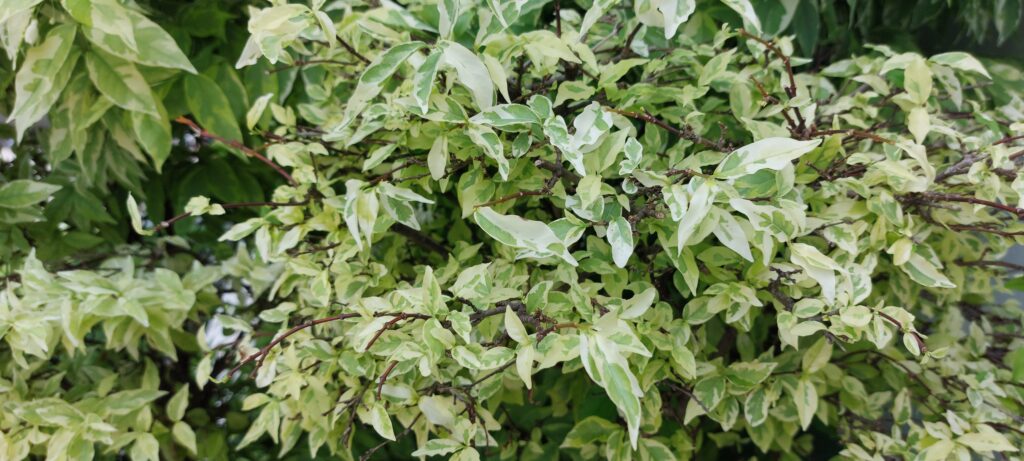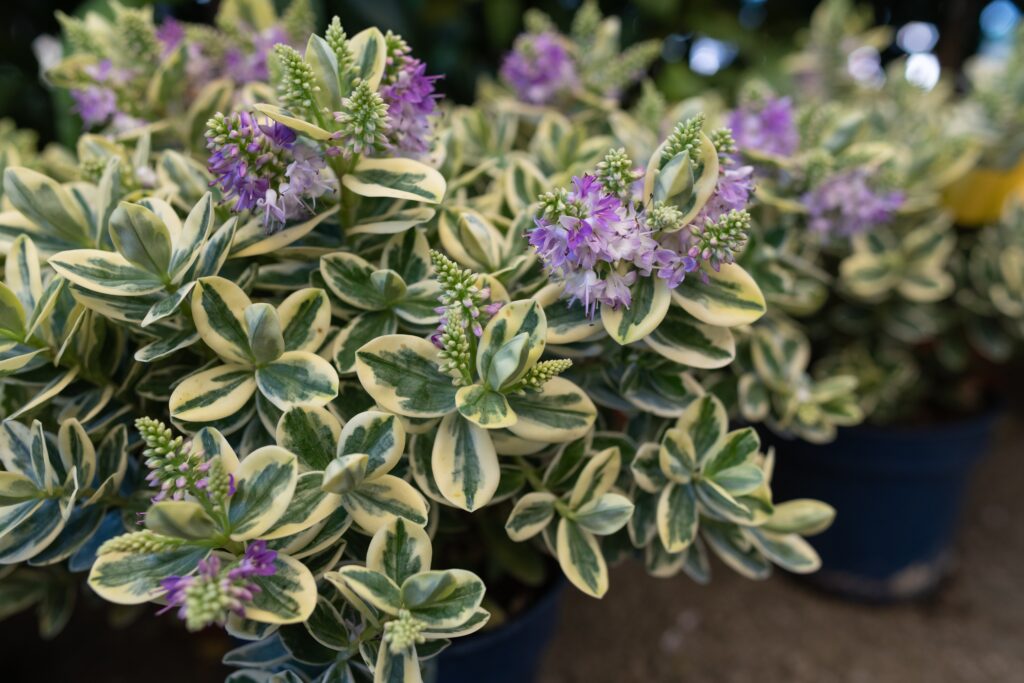When people think of the Pacific Northwest, they picture constant misty mornings, steady drizzle, and lush evergreen forests. But as locals know, summer tells a different story: rising heat, dry conditions, and growing gardens and landscapes. That’s because summer air circulation in the PNW shifts dramatically from winter patterns. Instead of the cool, moisture-rich breezes that flow in from the Pacific Ocean during the colder months, summer brings warm, dry air descending from the upper atmosphere. This seasonal shift, combined with climate change, is leading to hotter and more arid summers each year.

Image Credit: National Oceanic and Atmospheric Administration (NOAA) Climate Prediction Center
According to the National Weather Service CPC, the July–September 2025 forecast predicts a 50–60% chance of above-normal temperatures across southeast Washington, and a 40–50% chance for the rest of the state. In other words, warmer, drier weather is expected across the board.
That means one thing for landscapes: they need help adapting.
Understanding Summer Heat Stress in Plants
Just like us, plants can suffer from heat stress. And it doesn’t only show up when the soil is dry. Plants can be visibly stressed even after regular watering.
Signs your plants are heat-stressed:
-
- Wilted or curled leaves (especially midday, when the sun is at its highest point)
-
- Leaf scorch or browning edges
-
- Early leaf drop
-
- Discolored or faded foliage
-
- Stunted growth
It’s also important to note that overwatering and underwatering can look similar, and both cause harm. Overwatering suffocates roots and creates fungal problems. Underwatering weakens the plant’s structure and increases sun damage. The solution lies in adaptive watering practices and good soil prep, not just more water.
Water-Smart Practices for Healthy, Attractive Landscapes
Whether you’re caring for a home garden or managing a large commercial property, these summer strategies can help your landscape survive, and even thrive, through hot conditions:
-
- Water deeply and infrequently – Shallow, frequent watering leads to shallow root systems and water waste. Deep watering promotes strong, drought-resistant plants and cuts down evaporation.
-
- Mulch generously – Keep 2–3 inches of organic mulch (like bark, wood chips, or straw) around plants to insulate soil, retain moisture, and reduce weed competition throughout the year. Mulched soil stays cooler and healthier through dry months.
- Group plants by water needs – This helps conserve water and reduces the risk of over or under-watering.
- Improve soil health year-round – Healthy soil holds water better and helps plants resist disease and weather fluctuations.
Resilient Plants for PNW Summers
As climate patterns shift, it’s smart to invest in drought-tolerant and heat-adaptive plants, especially those suited to PNW climate zones. Native species are excellent choices because they’re naturally adapted to dry summer conditions.
Here are some standout performers:
Evergreen Shrubs & Statement Plants
-
- Wilma Goldcrest Cypress – Compact, lemon-scented evergreen with vivid yellow foliage.
-
- Kohuhu (Pittosporum tenuifolium) – Glossy evergreen with dark stems; great for hedging.
-
- Yucca – Bold and architectural, with sword-shaped leaves and tall flowering stalks.
Flowering Perennials & Shrubs
-
- Daphne (transatlantica & odora) – Fragrant and hardy, with blooms spanning spring to winter.
-
- Hebe – Attractive foliage with early summer blooms in a wide range of shades.
-
- Barberry (Berberis) – Tough, low-maintenance shrub with vibrant foliage and deer resistance.
Pollinator-Friendly & Native Options
-
- Bear’s Breech, Prunus virginiana, Mt. Atlas Daisy, and Vanilla Leaf (Achlys triphylla) – Adaptable choices for ornamental or native plantings.
-
- Ferns like Western Maidenhair (Adiantum aleuticum) – Ideal for shaded, damp corners of the landscape.
These plants not only survive drought, they look good doing it, making your landscape more vibrant and visually appealing even under stressful conditions.
Thinking Long-Term: Xeriscaping in the PNW
If you’re ready to reduce your water usage and create a truly sustainable landscape, xeriscaping may be the solution. Xeriscaping focuses on:
-
- Minimizing turf grass areas through alternative ground covers, ornamental grasses, and hardscaping elements like gravel, stone, or mulch.
-
- Grouping plants by water needs so irrigation can be applied efficiently and only where necessary.
-
- Using drought-tolerant, native species, and succulants that thrive with minimal irrigation, many of which are native or adapted to warm PNW conditions.
-
- Enhancing soil with compost and mulch to increase water retention and reduce runoff.
-
- Installing efficient irrigation systems, such as drip lines or soaker hoses, to target plant roots and eliminate waste.
This approach doesn’t mean sacrificing aesthetics. Originally developed in the arid regions of the American Southwest, xeriscaping is gaining popularity in the Pacific Northwest for its striking, natural design, low maintenance needs, and adaptability to our region’s changing climate.
The Ever-Changing Climate
Our region is shifting toward longer dry spells, hotter summers, and more frequent droughts. These changes aren’t just seasonal quirks; they’re part of a larger climate shift that’s already impacting our landscapes.
Much of Western Washington falls under the warm-summer Mediterranean climate (Csb) classification: mild, wet winters followed by warm, dry summers. But as global climate systems change, the PNW is becoming increasingly arid from July to early October. This is due in part to the expanding Hadley cell, a global atmospheric pattern that pushes warmer, drier air farther north each year.
What We Can Expect Going Forward
-
- Hotter, longer summers with increased days above 85°F
-
- More frequent and intense drought periods
- More frequent and intense drought periods
-
- Local water restrictions or higher utility costs for irrigation
-
- Stress on traditional landscaping, especially shallow-rooted or water-loving species
-
- Shifting plant hardiness zones, making it more difficult to rely on historical planting guidelines
What We Can Do to Adapt
-
- Plan landscapes with climate in mind – Carefully choose species that can handle extreme heat and inconsistent rainfall. Design around natural elements, and plan for smart irrigation, efficient plant layout, and long-term adaptability.
-
- Prioritize soil health – Healthy, organic-rich soil holds water more effectively and helps buffer plants from heat stress.
-
- Reduce water use – Install efficient irrigation systems like drip lines or soaker hoses and avoid overwatering, which wastes resources and can weaken plants.
-
- Minimize traditional turf areas – Replace water-intensive grass with ground covers, gravel, or low-maintenance plantings.
-
- Design for resilience – Group plants with similar water needs, and maintain proper spacing to reduce competition. Apply mulch to cool soil and reduce evaporation.
By understanding how the climate is changing and designing our landscapes to meet those challenges, we can create beautiful, low-maintenance spaces that thrive now and in the future. Sustainable landscape care isn’t just a smart choice; it’s becoming essential.
Summer Landscape Success Starts with Smart Care
As the Pacific Northwest continues to experience hotter, drier summers, maintaining a healthy, beautiful landscape takes intention and adaptability. Smart plant choices, proper watering techniques, and proactive soil care all play a role in helping your landscape not just survive the heat, but thrive in it.
Professional Care
Rising temperatures and shifting weather patterns make expert landscape care more essential than ever. At MSNW, we provide targeted, efficient solutions to keep your property healthy through the summer and beyond.
Our landscaping experts provide:
-
- Seasonal Maintenance – Timely pruning, irrigation adjustments, and plant health checks to reduce summer stress.
-
- Drought-Smart Design – Low-water plant selection, turf reduction, and layout improvements to conserve resources.
-
- Soil & Plant Health – Soil amendments and treatments to strengthen plants and boost resilience.
-
- Irrigation Optimization – Upgraded systems and maintenance that ensure efficient water use.
- Irrigation Optimization – Upgraded systems and maintenance that ensure efficient water use.




